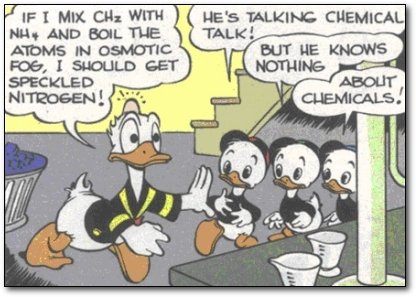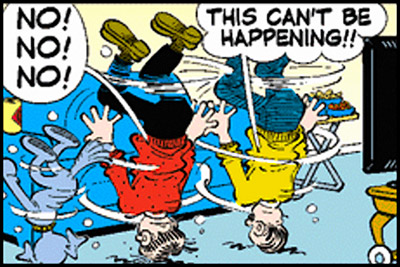The principal factor in my success has been an absolute desire to draw constantly. I never decided to be an artist. Simply, I could not stop myself from drawing. I drew for my own pleasure. I never wanted to know whether or not someone liked my drawings. I drew on walls, the school blackboard, old bits of paper, the walls of barns. Today I’m still as fond of drawing as when I was a kid — and that’s a long time ago… The incomparable Winsor McCay, quoted in a Los Angeles Times blog post that points out that this is the 100th anniversary of McCay’s short film Little Nemo. If you’ve never seen his animated shorts — they’re among the first examples of the medium, and yet still technically brilliant — you should hit up the YouTube and get started with Nemo…
Tag: comics
-
Little Nemo Turns 100
-
Donald Duck Discovered Methylene

Actually, he does. Donald Duck accidentally (and somewhat accurately) described the chemical compound methylene nearly two decades before real-world scientists:
In 1963, the Disney Studio learned just how wide and faithful a readership [Carl] Barks had. A letter arrived from Joseph B. Lambert of the California Institute of Technology, pointing out a curious reference in “The Spin States of Carbenes,” a technical article soon to be published by P.P. Gaspar and G.S. Hammond (in Carbene Chemistry, edited by Wolfgang Kirmse, New York: Academic Press, 1964). “Despite the recent extensive interest in methylene chemistry,” read the article’s last paragraph, “much additional study is required…. Among experiments which have not, to our knowledge, been carried out as yet is one of a most intriguing nature suggested in the literature of no less than 19 years ago (91).” Footnote 91, in turn, directed readers to issue 44 of Walt Disney’s Comics and Stories. … A year later, the Studio received a letter from Richard Greenwald, a scientist at Harvard. “Recent developments in chemistry have focused much attention to species of this sort,” Greenwald commented. “Without getting technical let me say that carbenes can be made but not isolated; i.e. they cannot be put into a jar and kept on a shell. They can, however, be made to react with other substances. Donald was using carbene in just such a manner, many years before ‘real chemists’ thought to do so.”
(Via Cracked’s 5 Amazing Things Invented by Donald Duck [Seriously])
-
Wrapped Snoopy House

An art world / comics story I hadn’t heard before: in November of 1978, a Peanuts strip ran in which Snoopy expresses his love for Christo and Jeanne-Claude’s ephemeral environmental installations. 25 years later the artists responded by presenting the Charles Schulz Museum with an actual reconstruction of Wrapped Snoopy House.
(Image above from Landfall Press, where you can buy a litho of the artists’ working collage for this piece)
UPDATE: there’s a nearly identical post over at Dinosaurs and Robots, dated almost exactly 24 hours before this post. I’d honestly not seen that when I posted this, so there must be something freaky going on in the collective unconscious…
-
Comics in the Courtroom

From the New York Times, a notice on an exhibition entitled “The Courtroom and Comics” at the Yale Law Library:
The medium serves as a guide to what was going on in society at the time, he said: “Comics are very much a reflection of pop culture.” The law has long been a part of that, whether it’s Perry Mason grilling a witness or Denny Crane blustering.
In the exhibition, many of the images have the power to delight, especially for those who collected comics in their youth. If your day job happens to be anything like mine — I’m the national legal correspondent for this newspaper — you will certainly notice that the comic book creators’ knowledge of law had a few gaps. For starters, the little girl in that Superman cover would have been seated in the witness chair, if in fact taking sworn testimony from a minor in open court was allowed in the Metropolis jurisdiction, and Superman would have been elsewhere in the courtroom. But you probably won’t mind that the creators sacrificed a bit of reality for drama, which is also why, you know, the main character can fly.
Mike Widener, the rare book librarian mentioned in the article, formerly oversaw the Law in Popular Culture collection at our own Tarlton Law Library here in Austin, which houses a great array of movies and books with lawyerly angles.
(Via the NY Times)
-
Humor and death: a qualitative study of The New Yorker cartoons (1986-2006)
A paper in the academic journal Palliative and Supportive Care analyzing perceptions of death and dying through the lens of New Yorker cartoons. Science!
“Personification of Death” (n = 38) included a subtheme of “Bargaining with Death.” The main theme included representations of death with human attributes, such as the Grim Reaper. Examples are the Grim Reaper sitting in a bar talking to another man; the caption reads, “Sometimes I give myself the creeps” (from 2005; Mankoff, 2006. p. 28). The subtheme involved people negotiating for more time to live. Many of the cartoons in this theme show the Grim Reaper standing at someone’s door as he or she tries to negotiate his or her way out of dying. For example, one such caption read, “Couldn’t I do a couple of hundred hours of community service instead?” (from 1990; Mankoff, 2006. p. 46). This can be seen as the legacy of death (Elgee, 2003), that we are all its slaves.
(Via NCBI ROFL)
-
Abner Mercury Memory

From a recently declassified history (PDF) detailing the NSA’s computing equipment up to 1964, comes a description of their house-sized computer ABNER’s mercury-powered memory banks:
A succession of pulses (signal or no-signal) travels through an acoustic medium, say mercury, from one end to the other of a “delay line.” […] At the input end of the line is a crystal that converts an electrical pulse to a mechanical wave which travels through the mercury to the other end, where another crystal reconverts it to an electrical signal. The series of electrical signals is recirculated back to input, after passing through detector, amplifier, and driver circuits to restore the shape and strength of the pulses. Also, in the part of the cycle external to the delay line are input and output circuits and “clock” pulses for synchronization. In mercury, the pulses travel at the speed of sound, which is much slower than the speed of electrical signals, and thus the delay in going from one end of the line to the other constitutes a form of storage. […] In ABNER, the mercury tank was a glass tube about two feet long; the delay time was 384 microseconds, or eight words of 48 bits at one-megacycle-per-second rate. Thus the 1,024 words were contained in two cabinets holding 64 mercury delay lines each.
ABNER was named after comic strip character Li’l Abner, reportedly because it was a big, hulking machine that “didn’t know anything”.
(Via Bruce Schneier)
-
On the Longevity of Sam & Max
Yeah, it’s great. A lot of that is the fans that have kept it alive. When people discovered it, they would be such rabid fans of it they would feel like they were the ones that got it. It was a little too obscure for their friends, maybe, but they were the ones that were getting it. A thing about the old comics I always heard was that people would lend them to their friends and never get them back. It was always this process where you’d be trying to turn someone onto it, which I thought was great. So there was a long stretch where I didn’t do anything with Sam & Max and there were fan sites that were keeping them active, so I attribute that [to the fact] they’re still around.
The Onion A.V. Club catches up with and gets a good interview from my favorite cartoonist Steve Purcell to ask him about Monkey Island, Sinistar, and the new season of Telltale’s adaptation of his creation.
Fun fact: one of the first websites I created way back in 1994 was a Sam & Max fan site with a handful of scans from the comics and related ephemera, so I guess I was one of those fans!
-
Uncle Fester Laughing in Theater

The New York Times has up a nice review of the new Charles Addams exhibit at the Museum of the City of New York:
The city street is dark and deserted. The buildings are empty. There are no witnesses. A lone man carrying a briefcase, after a long day at the office perhaps, approaches a subway staircase. Out of the subterranean gloom, a giant human hand protrudes, its index finger beckoning the office worker, inviting him into the depths. His eyes are wide with astonishment, his face showing the hint of a grin, as if the bizarre, illicit invitation were not entirely unwelcome. […]
Above is my personal favorite Addams cartoon, perhaps one of my favorite cartoons of all time. His drawings are often cited as finding their humor and inspiration in the macabre — I think their lasting appeal comes more from his ability to find joy in laughing at and rejecting the bleakness of modern life.
-
Dagwood: No! No! No! This Can‘t Be Happening!!

From today’s Blondie strip, proof that even the boring legacy comics can be delightfully weird and fun sometimes. Maybe they’re trying to out-Sluggo Sluggo?
-
Winsor Mccay‘s 1911 Animation of Little Nemo
Winsor McCay’s 1911 animation of his Little Nemo comic strip (embedded above) was selected this year by the U.S. Library of Congress to be entered as a culturally significant work in the National Film Registry (along with Michael Jackson’s Thriller, The Muppet Movie, and others). Knowing that McCay did this all himself, by hand, cranking out tens of thousands of hand-colored drawings (keep in mind he was also pioneering the field of animation, inventing techniques as he worked) in addition to his incredibly intricate newspaper work leads me to suspect he was living in an alternate stream of time than the rest of us. Incredible stuff.
(Via Cartoon Brew)
